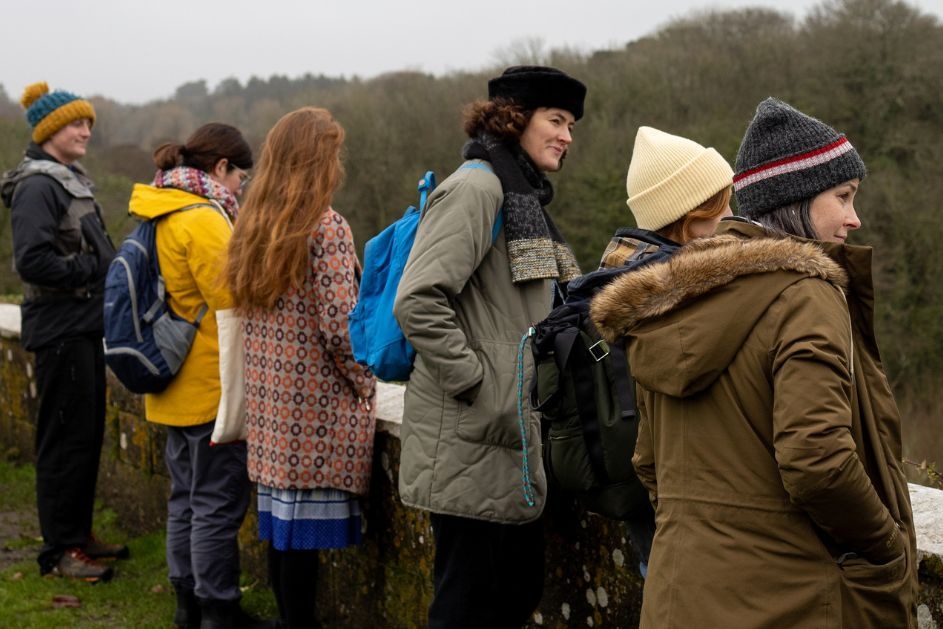Across 2024 we’re supporting the eight Wales-based artists participating in the Future Wales Fellowship, working in partnership with the Arts Council of Wales, Natural Resources Wales, the Elan Valley Trust and National Trust. The Fellowship supports artists to develop research exploring the complex relationship between humans, nature, place and climate.
In February we gathered for the very first residential, meeting at National Trust’s Stackpole site. We met and walked with ecologists, rangers and curators, and we heard from each Future Wales Fellowship artist – Manon Awst, Cheryl Beer, Zillah Bowes, Eric Lesdema, Alison Neighbour, Simmy Singh, Julia Thomas and Iestyn Tyne - as they began thinking, imagining, researching and making.
In this update, we’re sharing with you the starting points of each artist, and we’ll delve more into each artist’s practice in the coming months.
Manon Awst
Manon’s research – titled Connect and Stick to It – will navigate fragile ecologies and earthly materials, exploring recipes for making sculptural interventions that ‘stick’ around. Working across human and more than human processes and weaving across the different temporal entanglements within peat bogs, the research will explore ideas of stickiness and ask in what ways sticky sculptures can ‘stick’ to places and stick us to them.
Cheryl Beer
Cheryl begins from the feeling that everything is temporary, and that everything can change in a millisecond. This vulnerability, felt personally, is also shared with the ecology of everything that’s around us. Through the fellowship Cheryl is exploring ways to listen to the voice of nature. Working with spectral frequencies, and technologies that usually look for what’s absent, Cheryl looks for what’s present, notating landscapes to find physical manifestations of voice and melody.
Zillah Bowes
Within Zillah’s practice, her work is often trying to find that space which takes you elsewhere – into the body, the earth and otherworldly places. Zillah’s fellowship research is exploring ideas of environmental personhood, and the ways of thinking and imagining which these conversations and designations make possible. She hopes to work with linguists to consider ways of speaking about / to / with nature, finding new tools for interconnected communication.
Eric Lesdema
Eric’s research emerges from histories of enclosure, of both the land and the mind, working in dialogue with anthropologists, linguists and historians. Strands of thinking consider boundary lines, delineations of power, shifts from common to private interests and who shapes the narrative of how these stories are told. Eric asks who is cultivating and who is conserving, walking through histories to explore our collective psychology.
Alison Neighbour
Alison’s practice explores ecosystems of interdependence, and through her fellowship research – titled Finding Common Ground – Alison will be thinking about how we live with our disproportionate impact on the planet, questioning materials and the life cycle of physical things. Emerging ideas are considering the structures that carry us and gather us, thinking about rituals and rhythms from the everyday to the planetary.
Simmy Singh
As a composer and violinist, Simmy is interested in the potential of the concert space as a sacred place of ceremony. Drawing on the thinking of eco-philosopher Joanna Macy, and her writing on ‘The Great Turning’ as a moment to embrace new creative responses for a life-sustaining society, Simmy is exploring the potential of hosting concerts in places of nature, for and with particular beings and in collaboration with other musicians.
Julia Thomas
Julia begins with the question of what we understand as ‘human nature’, thinking about how a story is told, whose voice a story is carried by, and with whom it’s being shared. Drawing on processes of working with writers and actors, Julia will explore intergenerational relationships with Sandy Water Park (previously the site of Llanelly Steel Works), listening to different perspectives on the climate crisis through the context and personal histories of one site and its community.
Iestyn Tyne
Iestyn’s fellowship project – Llif – emerges from the piece of land, or a version of the piece of land, where Iestyn grew up. Considering ideas of succession – from the perspective of his parents being first-generation farmers - Llif will explore community voices; land use; traces of colonialism; climate change; and the richness of situated, embodied knowledge. From the falling of a single tree, Iestyn will trace ideas of land guardianship, and ask who might determine a land’s future patterns.
The Future Wales Fellowship is part of the Creative Nature Programme between Natural Resources Wales and Arts Council of Wales. The programme aims to cultivate the relationship between the arts and the natural environment, as part of a shared commitment to improve the environmental and cultural well-being of Wales. This iteration of the Future Wales Fellowship is being delivered in partnership with the Elan Valley Trust, National Trust and Peak Cymru.


